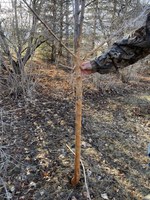Dakota Gardener: The big reveal
(Click an image below to view a high-resolution image that can be downloaded)
By Joe Zeleznik, Forester
NDSU Extension
My wife and I were watching one of those home remodeling shows the other day. At the end of all the work there’s always “the big reveal,” where the homeowners get all excited about the fancy new furnishings and décor.
We’re not going to be doing any major remodeling any time soon. It’s too expensive.
Now that the snow has finally melted, we’re getting a different kind of reveal – all of the damage that our trees suffered over the winter. It was long and it was tough, and the wildlife did what they needed to survive.
My wife and I watched this winter as a doe and fawn munched on twigs of our apple trees. They also nibbled the mugo pine, the sumacs, a hydrangea, a Kentucky coffeetree and even a lilac. I’m not too worried about the deciduous trees and shrubs. Though some of the buds have been removed, there are still plenty left. Deciduous plants are generally good at creating new buds.
The mugo pine is in trouble, though. For conifers, once the buds are gone on a particular branch, they’re gone for good and that branch won’t continue to grow. About half of the crown of that shrub is gone and I fear it won’t recover.
One thing I didn’t worry about this past winter was rabbits eating the bark off my apple trees. I have fences around the trees, and when the snow got too high, I went out and stomped it down or shoveled it away from the fence. Rabbits are deadly to trees in the winter.
My neighbor Rick called a couple of weeks ago in desperation. Rabbits had completely girdled six out of eight apple trees in his yard. It was the worst rodent damage either of us had ever seen. One tree was stripped from the ground to a spot about four feet high. Another girdled tree was at least four inches in diameter, at ground level. That’s a big tree, and I wouldn’t have expected the rabbits to eat the thick bark from a tree that size.
But they did and now the tree is toast. (Toast – not a technical term.) If the bark is removed all the way around the stem, the tree won’t recover.
The melting snow was a big reveal, that’s for sure. But in this case, it revealed devastation, which I had to confirm. The damage was done and there was nothing that he could do.
I’ve had to deliver a lot of bad news this spring and it hasn’t been fun.
Another “reveal” this spring has been the amount of damage by woodpeckers on a number of trees. Bur oaks, for example, have an insect pest called Callirhytis flavipes, a tiny stingless wasp that doesn’t have a common name. The insect overwinters in the bark of the twigs and smaller branches, and that’s where woodpeckers dig for them, gaining small protein-packed meals.
Woodpeckers also damaged our own trees this winter. We feed them suet over the winter, which brings them into the yard every day. While they’re waiting their turn at the feeder, they inspect the trees in the yard, exploring the bark for any insects that might be overwintering there. In the process, a lot of bark gets knocked off the trees. While there’s nothing we can do about it, next winter we might not put out suet.
A lot of physical injuries were revealed this past month as well. There was damage from heavy snow, ice, salts, snowblowers and plows, but we don’t have enough time to go into that. What was revealed in your trees?
NDSU Agriculture Communication – May 2, 2023
Source: Joe Zeleznik, 701-730-3389, joseph.zeleznik@ndsu.edu
Editor: Kelli Anderson, 701-231-6136, kelli.c.anderson@ndsu.edu




